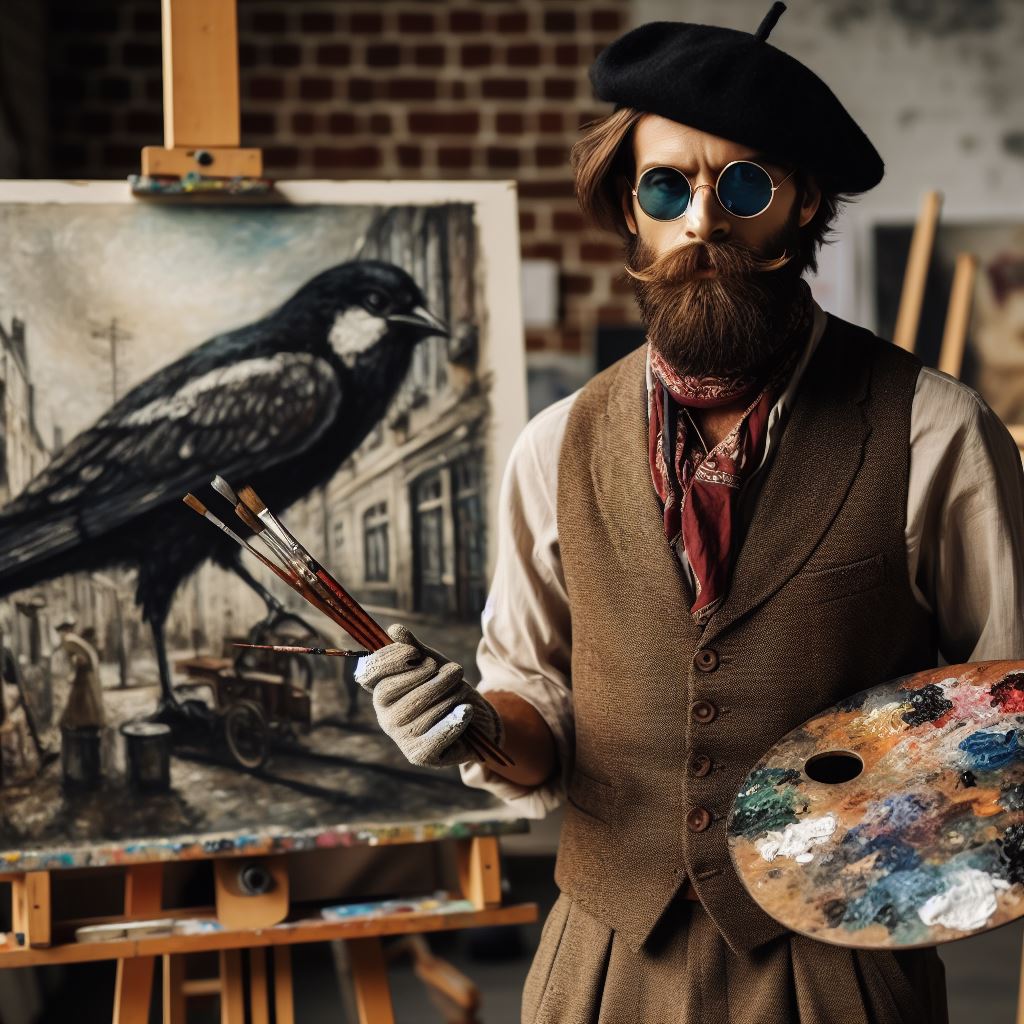Introduction
In the vibrant realm of artistic expression in Australia, the significance of Intellectual Property (IP) law stands as a beacon, safeguarding the creative endeavors of artists.
This blog post sets out to illuminate the nuanced landscape of IP law tailored specifically for Aussie artists, recognizing the vital role it plays in preserving and fostering innovation within the artistic community.
Artists, as custodians of cultural expression, embark on journeys of creativity, often crafting pieces that resonate with profound originality.
As we delve into the realm of intellectual property, the legal framework that underpins the protection of these artistic endeavors becomes a focal point.
This exploration is designed to serve as a comprehensive guide for Aussie artists navigating the intricacies of IP law, unraveling its layers to empower creators with the knowledge essential for securing their intellectual contributions.
Creativity is the lifeblood of the artistic field, driving innovation, and shaping cultural narratives.
The importance of protecting this creativity cannot be overstated, and it is within the contours of IP law that artists find the necessary legal safeguards.
By affording artists the means to protect their intellectual assets, IP law becomes a cornerstone in fostering an environment where creativity can flourish without the looming threat of unauthorized use or infringement.
Join us on this journey into the world of IP law tailored for Australian artists, where the intersection of legal principles and creative pursuits defines the landscape.
As we unravel the legal intricacies, we not only provide a roadmap for artists to navigate but also advocate for the fundamental right of creatives to protect, nurture, and thrive in their artistic expressions.
Understanding Intellectual Property (IP) Law
In the creative industry, intellectual property (IP) law plays a crucial role in protecting the rights of artists and encouraging innovation and creativity.
Let’s delve into the significance of intellectual property and the various types of IP protection available.
Define Intellectual Property and Its Significance in the Creative Industry
- Intellectual property refers to original creations of the mind, such as inventions, designs, artistic works, and symbols.
- It is crucial in the creative industry as it provides legal protection to artists’ creations.
- IP rights enable artists to control and monetize their work, giving them an incentive to continue creating.
- By safeguarding intellectual property, artists can prevent unauthorized copying and ensure fair competition.
Different Types of IP Protection (Copyright, Trademarks, Patents, etc.)
- Copyright is the most common form of IP protection for creative works, including music, literature, and art.
- It grants exclusive rights to the creator, allowing them to reproduce, distribute, and display their work.
- Trademarks protect distinctive signs, such as logos or brand names, that distinguish goods or services.
- Patents are granted for inventions, providing exclusive rights to the inventor for a certain period.
- Design rights protect the visual appearance of a product, preventing copying of its unique features.
- Trade secrets, such as confidential business information, can also be protected as IP.
How IP Law Supports and Encourages Innovation and Creativity
- IP law provides an incentive for artists and innovators to invest time, effort, and money into their creations.
- By granting exclusive rights, it allows creators to reap the rewards of their work, fostering further innovation.
- IP protection promotes a competitive marketplace, as artists can confidently showcase their originality.
- It encourages collaboration and licensing agreements, enabling artists to share their work while retaining control.
- Furthermore, IP law stimulates economic growth by attracting investments and fostering technological advancements.
In a nutshell, intellectual property law is vital in the creative industry, as it safeguards artists’ original works and encourages innovation.
By understanding the different forms of IP protection, artists can ensure their creations are protected from unauthorized use.
The legal protection provided by IP law serves as a catalyst for creativity and economic growth in the artistic community.
Read: Melbourne’s Literary Scene: A Guide
Copyright Protection for Aussie Artists
In this section, we will explore the importance of copyright protection for Australian artists and the various aspects associated with it.
What is Copyright?
Copyright is a legal concept that provides creators with exclusive rights over their original artistic works.
These works can include paintings, sculptures, photographs, drawings, music, literature, films, and other creative expressions.
It allows artists to control how their works are used, copied, distributed, performed, or displayed.
The Automatic Copyright Protection
In Australia, copyright protection is automatic once an artistic work is created.
Artists do not need to register their works or use a copyright symbol for protection.
This means that as soon as an artist creates an original work, they have the copyright to control its use.
Benefits of Registering Copyright
While copyright protection is automatic, there are benefits to registering your artistic works.
- Registration provides evidence of ownership in case of disputes or infringement claims.
- It acts as a deterrent to potential infringers, as they can easily determine your rights.
- Registered copyrights can be assigned or licensed to others, providing additional revenue streams.
The Process of Registering Copyright
To register copyright in Australia:
- Complete the necessary application forms, available on the Australian Copyright Council website.
- Pay the required filing fee, which varies depending on the type of work being registered.
- Provide a copy or representation of the work being registered, as well as any supporting documentation.
- Submit the application and supporting documents to the Australian Copyright Council.
- Once accepted, you will receive a copyright certificate as proof of registration.
Duration of Copyright Protection
In Australia, copyright protection for artistic works generally lasts for the lifetime of the artist plus 70 years.
Upon the artist’s death, their copyright may be inherited by their estate or passed on to other beneficiaries.
Your Personalized Career Strategy
Unlock your potential with tailored career consulting. Get clear, actionable steps designed for your success. Start now!
Get StartedAfter the copyright term expires, the work enters the public domain and can be freely used by others.
In review, copyright protection plays a crucial role in safeguarding the creativity and rights of Australian artists.
While automatic protection exists, registering copyright offers additional benefits and legal evidence.
Understanding the process and duration of copyright protection empowers artists to protect and monetize their artistic works effectively.
Read: Salary Trends for Aussie Journalists
What are Trademarks?
Trademarks are distinctive signs used by artists to identify goods or services they offer in the market.
The Relevance of Trademarks for Artists
Trademarks are relevant for artists as they serve as a form of protection for their artistic identity and branding.
Protection for Branding and Artistic Identity
Trademarks offer artists legal protection against unauthorized use of their artistic creations, ensuring their branding is unique and easily distinguished.
Registering Trademarks for Artists
Artists can register their trademarks by following a few steps. Firstly, they need to conduct a comprehensive search to ensure their chosen trademark is unique and available.
This can be done through conducting a trademark search online, or seeking professional assistance.
Once the uniqueness of the chosen trademark is confirmed, artists can proceed with the filing of a trademark application, which can be done online or through a paper application.
Benefits of Trademark Protection
Trademark protection provides several benefits for artists. Firstly, it grants exclusive rights to use the trademark in connection with their goods or services, providing them with a competitive edge in the market. It also allows artists to prevent others from using similar marks, reducing the risk of brand confusion.
Additionally, trademarks can increase the market value of an artist’s work, as consumers often associate trademarks with quality and reliability. This can lead to increased sales and collaborations with reputable brands.
Limitations of Trademark Protection
While trademark protection is valuable, it does have limitations.
Trademarks are limited to the specific goods or services they are registered for, meaning that artists need to ensure they register their trademarks for all relevant categories to ensure comprehensive protection.
Furthermore, trademarks are only enforceable within the jurisdictions they are registered in. Artists who wish to protect their trademarks internationally may need to file separate applications in each desired country.
Stand Out with a Resume That Gets Results
Your career is worth more than a generic template. Let us craft a resume and cover letter that showcase your unique strengths and help you secure that dream job.
Get HiredIn some cases, trademarks may also face challenges during the registration process if they are deemed too generic or similar to existing trademarks. This can result in delays or rejection of the trademark application.
In essence, trademarks are essential for Australian artists to protect their creativity, branding, and artistic identity.
Artists should consider registering their trademarks to avail themselves of the benefits and effectively manage the limitations associated with trademark protection.
By understanding the concept of trademarks and taking appropriate steps, artists can safeguard their unique branding and artistic expression.
Read: Children’s Authors in Oz: A Special Niche

Patents and Designs
Introducing Patents and Designs in the Artistic Sector
- Patents and designs play a crucial role in protecting intellectual property in the artistic industry.
- Both patents and designs provide legal protection for original and innovative creations.
Eligibility Criteria for Obtaining a Patent or Design Right
- To obtain a patent for an artistic creation, it must be new, inventive, and industrially applicable.
- Designs must be new and have an individual character, differentiating them from existing designs.
Advantages of Patent or Design Registration for Artists
- Patent registration grants exclusive rights to artists, allowing them to prevent others from using their invention.
- Design registration protects an artist’s unique visual appearance, preventing others from copying or imitating it.
Limitations and Considerations when Pursuing Patent or Design Protection
- Artists need to be aware of the costs associated with obtaining and maintaining patents or design registrations.
- The process of obtaining a patent or design right can be time-consuming and requires technical and legal expertise.
- Patents have a limited term, typically 20 years, and artists must enforce their rights to prevent infringement.
- Designs have a shorter term, typically 10 to 25 years, and artists must regularly renew their registrations.
In fact, patents and designs are essential tools for protecting the creativity of Australian artists. By obtaining patent or design registration, artists can safeguard their original creations and maintain a competitive advantage in the market.
However, artists should carefully consider the costs, time, and limitations associated with pursuing patent or design protection.
It is crucial for artists to consult with legal professionals specializing in intellectual property law to ensure the best possible protection for their artistic works.
Read: Ghostwriting in Australia: An Insider’s View
Discover More: Horror Writing Down Under: A Snapshot
Enforcing IP Rights
Importance of Enforcing IP Rights for Artists
Protecting intellectual property (IP) is crucial for artists as it safeguards their creative works from unauthorized use or exploitation. Enforcing IP rights ensures that artists have control over their creations and can benefit financially from them.
Legal Remedies for IP Infringement in Australia
In Australia, artists have several legal remedies available to combat IP infringement.
These include seeking injunctions to stop the unauthorized use of their work, claiming damages for any financial loss suffered, and obtaining court orders for the delivery or destruction of infringing materials.
Handling and Preventing IP Disputes
Artists can take proactive steps to handle and prevent IP disputes. Registering their creative works with IP Australia provides legal evidence of ownership and strengthens their position in case of infringement.
Additionally, artists can draft clear and comprehensive licensing agreements to establish the terms of use for their work.
Role of Mediation, Arbitration, and Litigation in IP Infringement Cases
Mediation plays a pivotal role in resolving IP disputes as it allows artists and infringers to collaborate on finding a mutually acceptable solution.
Mediation is a flexible and cost-effective alternative to litigation, fostering an amicable atmosphere for negotiation.
Arbitration is another option for resolving IP disputes, where an impartial third party makes a binding decision based on evidence presented by both parties.
Arbitration can be faster and more confidential than traditional litigation, providing artists with a fair and efficient resolution process.
However, if all other avenues fail, litigation may be necessary.
Artists can file a lawsuit in the Federal Court of Australia, seeking judicial remedies such as damages, injunctions, and orders for the disposal of infringing goods.
Litigation can be time-consuming and costly, but it can also provide a definitive legal resolution.
Best Practices for Artists to Protect Their IP Rights
To safeguard their creativity, artists should adopt best practices such as copyrighting their work, using watermarks, and including copyright notices on their creations.
Regular monitoring of the market and online platforms can help identify potential infringements, allowing prompt action to be taken.
Collaboration with Legal Professionals
Engaging with IP lawyers can be invaluable for artists seeking to protect their IP rights effectively. These professionals can provide expert advice on IP registration, licensing agreements, and enforcement strategies.
By working closely with legal experts, artists can ensure their rights are adequately protected.
Educating the Public and Raising Awareness
Artists can contribute to the protection of their IP rights by actively engaging in public education and awareness campaigns.
By fostering a culture that respects and values creative works, artists can reduce the likelihood of infringement and promote a fairer environment for all creators.
Enforcing IP rights is imperative for Aussie artists to protect their creativity and secure the rewards of their hard work.
By understanding legal remedies, handling disputes proactively, and collaborating with legal professionals, artists can safeguard their IP rights and continue to thrive in their artistic endeavors.
Conclusion
In culmination, our exploration into intellectual property (IP) rights for Australian artists has illuminated crucial facets of safeguarding creative endeavors.
We’ve underscored the paramount importance of comprehending the nuances of IP laws, emphasizing the power these regulations wield in shielding artists’ innovations and expressions.
Throughout this discourse, we’ve delved into the multifaceted realm of IP rights, from copyrights and trademarks to the protection of unique artistic expressions.
The recognition that these rights provide is not merely legal, but a validation of the artist’s creative identity and a bulwark against unauthorized use.
The significance of understanding and actively protecting these rights cannot be overstated.
It is a proactive stance that empowers artists, ensuring that their creations are shielded from infringement and exploitation.
Furthermore, the fostering of a culture that respects IP rights cultivates an environment where creativity can flourish without fear of misappropriation.
As we conclude, we urge artists to actively safeguard their intellectual property as vigilant custodians.
Transform Your LinkedIn for Maximum Impact
Elevate your professional brand with a LinkedIn profile that attracts recruiters, showcases your expertise, and maximizes opportunities. Stand out in your industry with a profile built for success.
Boost ProfileEffectively navigate complexities by mastering IP laws and seeking professional advice for a comprehensive understanding of the subject.
Consulting with legal experts specializing in intellectual property is a strategic investment in the longevity and prosperity of an artist’s work.
In essence, the safeguarding of intellectual property is an active pursuit, a responsibility that extends beyond the canvas or creation.
It is a commitment to preserving the integrity of artistic visions and, in doing so, contributing to the vibrancy of Australia’s artistic landscape.
Let the knowledge gained in this exploration serve as a catalyst for artists to assert their rights, ensuring that the legacy of their creativity remains resilient and enduring.




